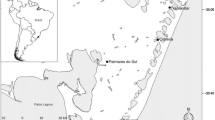Abstract
Biodiversity patterns of the woodland-steppe ecotone in southeastern Inner Mongolia were investigated. Controlled by climatic factors, the plant species diversity of the woodland-steppe ecotone is moderate as compared with the adjacent woodland and steppe communities. From woodland through woodland-grassland and woodland-steppe to steppe, about 2/3 species were replaced at each boundary; only seven herb species were detected to be distributed in all four vegetation zones. Landscape classification based on landform, climate, and vegetation shows that landform condition is most critical to landscape diversity in the studied area. The most fragmented landform in the woodland zone does not necessarily lead to low plant species diversity. However, similar understory species in different woodland types lead to continuous woodland vegetation and, hence, high species richness. High fragmentation in the woodland-steppe zone and discontinuous distribution of woodlands might be a driving factor for lower species richness. Reconstruction of the Holocene climatic changes and vegetation development demonstrates that the highest plant species diversity occurred in the ecotone from 4500 to 2500 14C yr BP at different sites, while the woodland zone extended much farther northwestward. When woodlands retreated from the current ecotone with climatic drying, the fragmentation of woodlands in the current ecotone led to plant species loss.
Similar content being viewed by others
References
R. P. Neilson, Ecological Applications 3(3), 385 (1993).
O. Honnay, K. Piessens, W. Van Landuyt, et al., Landscape and Urban Planning 63(4), 241 (2003).
O. Honnay, M. Hermy, and P. Coppin, Biological Conservation 87(1), 73 (1999).
J. Benitez-Malvido and M. Martinez-Ramos, Conservation Biology 17(2), 389 (2003).
H. Liu, H. Cui, R. Pott, and M. Speier, J. Vegetation Science 11(4), 525 (2000).
D. Mueller-Dombois and H. Ellenberg, Aims and Methods of Vegetation Ecology (John Wiley and Sons, New York, 1974).
M. A. Huston, Biological Diversity: The Coexistence of Species on Changing Landscapes (Cambridge University Press, 1994).
R. M. Whittaker, Taxon 21, 3 (1972).
M. L. Cody, in Conservation Biology: The Science of Scarcity and Diversity, Ed. by M. E. Soule (Sunderland, Massachussetts, Sinauer, 1986), pp. 122–125.
H. Liu, H. Cui, P. Yu, and Y. Huang, Plant Ecology 158(3), 139 (2002).
H. Liu, L. Xu, and H. Cui, Quaternary Research 57, 259 (2002).
Editorial Committee of Flora of Hebei Province, Flora of Hebei Province, Vols. I, II (Hebei Remin Press, Shijiazhuang, 1989) [in Chinese].
Editorial Committee of Flora of Hebei Province, Flora of Hebei Province, Vol. III (Hebei Remin Press, Shijiazhuang, 1992) [in Chinese].
Editorial Committee of Flora of Inner Mongolia, Flora of Inner Mongolia, Vols. I–V (Inner Mongolia Remin Press, Huhhot, 1994) [in Chinese].
Z. Liu and S. Liu, Grassland Ecosystem Research, No. 2, 1 (1982) [in Chinese].
H. Zhu, Z. Xu, H. Wang, and B. Li, Biodiversity and Conservation 13(7), 1355 (2004).
S. Walker, J. B. Wilson, J. B. Steel, et al., J. Vegetation Science 14(4), 579 (2003).
Survey Team of Remote Sensing Application in Grassland Resources in Inner Mongolia, Atlas of Natural Resources in Inner Mongolia (Science Press, Beijing, 1988).
A. G. Brown, J. Biogeography 26(1), 19 (1999).
H. Liu, H. Cui, and Y. Huang, J. Quaternary Science 16(3), 237 (2001).
J. Lovett-Doust, M. Biernacki, R. Page, et al., Landscape Ecology 18(6), 621 (2003).
A. Norderhaug, M. Ihse, and O. Pedersen, Landscape Ecology 15(3), 201 (2000).
Author information
Authors and Affiliations
Corresponding author
Additional information
© Hongyan Liu, Haiting Cui, 2009, published in Sibirskii Ekologicheskii Zhurnal, 2009, Vol. 16, No. 4, pp. 539–548.
This article was submitted by the authors in English.
Rights and permissions
About this article
Cite this article
Liu, H., Cui, H. Patterns of plant biodiversity in the woodland-steppe ecotone in southeastern Inner Mongolia. Contemp. Probl. Ecol. 2, 322–329 (2009). https://doi.org/10.1134/S1995425509040043
Published:
Issue Date:
DOI: https://doi.org/10.1134/S1995425509040043




